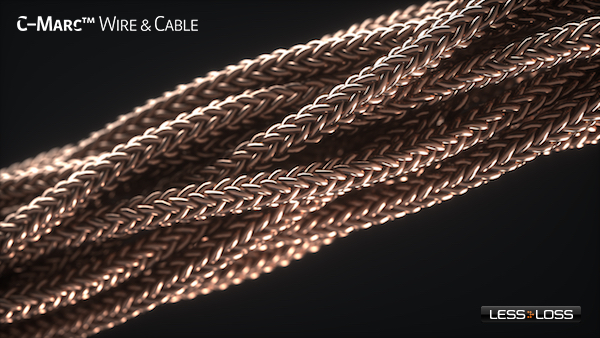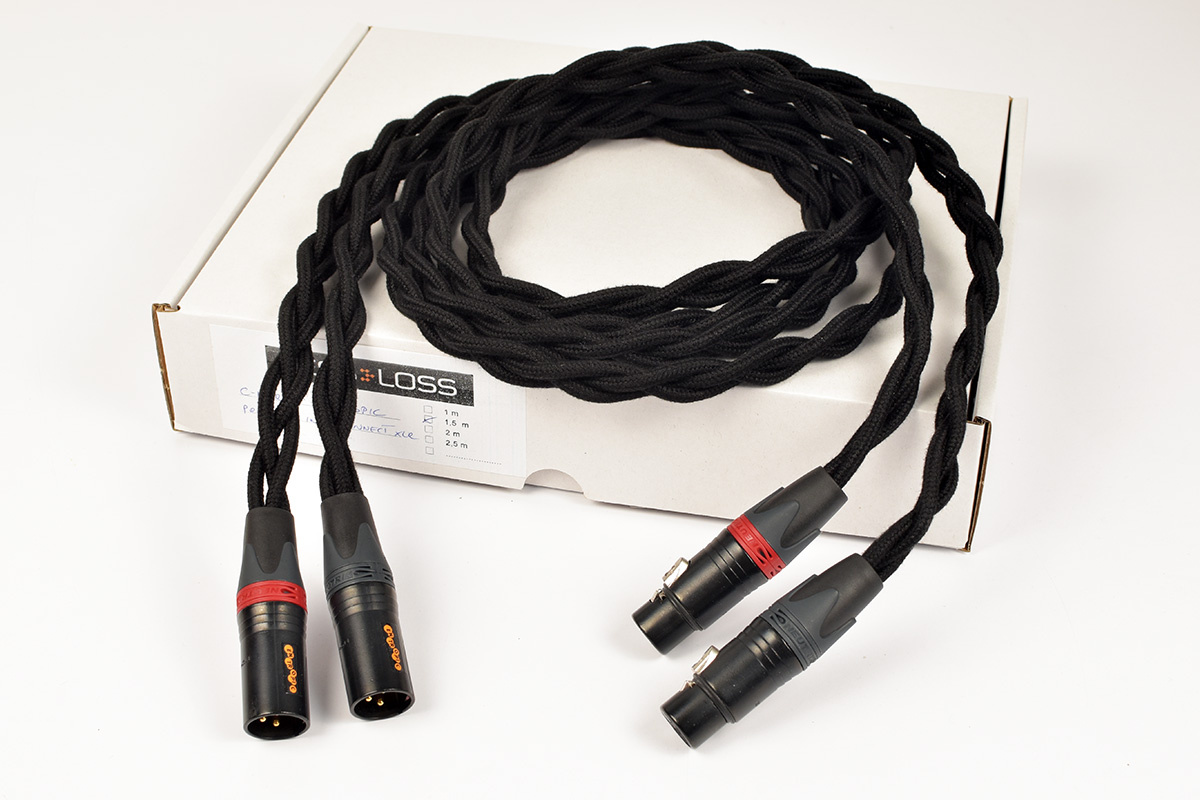LessLoss C-MARC™ Entropic Process Interconnect - XLR
- Introducing C-MARC™. A new generation of high performance wire and cable, well-equipped to deal with today’s over-polluted electro-magnetic environment.
LessLoss C-MARC™ Entropic Process Interconnect - XLR
C-MARC™ is a new type of Litz wire. C-MARC’s noise reduction is based on the bucking coil method using two counter-polarized coils. Every strand's clock-wise turn aligns with a corresponding counter-clockwise turn of exactly mirrored diameter and step. The two resulting counter-polarized coils are mutually superposed. A second-scale fractal replication of the already bucking coils is then repeated. Through electrical cancellation of the induced noise, C-MARC™ provides an enormous signal-to-noise ratio in today's demanding environment.
C-MARC™ stands for Common-mode Auto-rejecting Cable.
C-MARC™ is unlike any other hookup wire or cable currently being produced. It is based on the bucking coil method of noise reduction, used most famously in twin coil pickup designs first developed in the mid-1930's to silence hum from electric guitars.
This type of guitar pickup was called the Humbucker because it 'bucks the hum,' i.e. noise, out of the desired guitar signal through phase cancellation of two counter-polarized inductors. When the inductors both induce a common signal, it is induced in opposite polarities by each coil. These opposite polarities then mutually cancel when the two counter-polarized noise currents are combined through simple electrical summation. Humbucking coils are also used in some microphone designs as well as in sensitive sensor technology where induced stray noise is not acceptable and the highest signal to noise ratio is desired.
Entropic Process: a most profound LessLoss technology
Pictured above is the new insignia of the ultimate LessLoss achievement. When you see this signage, you know that sonics don't get any better than this!
We investigated the mysterious burn-in phenomena over 20 years, following it very closely, and learning ever more about it, until we figured out a way to actually use it in design of actual product. This has been on our creative minds ever since day one when we first experienced it decades ago. But it remained elusive to us, until now!
This does not mean we have abolished all initial changes in sound quality. It only means we developed means and methods to accelerate it, pre-prime it, so to speak, to the point where in your first two weeks of listening you might go through, say, some 200 years of regular burn-in. The burn-in process has not been downtrodden by us, but put on steroids to serve us even better! This is the genius of the new Entropic Process.
Prerequisites in order to comprehend this.
If you have never experienced any strange burn-in effects, you will not yet know whereof we speak. The strange burn-in effect remains undoubtedly, the most mysterious of all aspects involved in high end audio. Appreciated, experienced, and tolerated by thousands, understood by none, it remains an uncracked code of mystery which has represented a strange bottleneck to designers until now. Sometimes it is a cause of ridicule, but sooner or later everyone experiences it and tones down their cynicism.
What is burn-in?
Burn-in is a strange phenomenon in which newly made gear, or cables, go through a series of inexplicable initial transitional phases in terms of performance. One day the sound may be brittle and course, and another day the sound may be rubbery and elastic. One may experience phases of bass-heavy submersion as if one is under water, and then periods where one feels the woofers are too weak in balance with the mids and treble. Eventually these two extremes converge into a balanced, stable performance, a mature and pleasant tonal balance. This process is dependent on two things.
First, it depends on what the total system transparency is. If the system has deep flaws, such as being located in a room with ceramic tiles and many exposed glass windows, of course this acoustic echo chamber will mask such effects greatly. But if the system is set up well in an acoustically well organized space, you'll easily hear them.
Secondly, it depends on how sonically neutral the fresh product actually is. If it is severely skewed in some arbitrary tonal direction, it will be more difficult to sense just what is going on in terms of this burn-in process. An example of this is found in multi-strand copper conductors with silver plating. But if the product is a sonic giant in terms of its ability to portray just what is going on in the recording, without editorializing, one will hear huge burn-in swings initially.
It is most likely that LessLoss products portray exactly the same changes that any new wire goes though. The only difference is that C-MARC has such a fantasically low noise floor, that one can more readily perceive and experience these large burn-in swings because so much more detail is exposed to the listener than usual. It goes without saying that you simply can't have it both ways: you cannot expect a totally transparent cable to reveal real data on a recording that won't simultaneously also reveal a much deeper underlying physical aspect of burn-in as it matures and settles in performance. The performance is the ability to show ever more minute change in signal. This also must mean, at the same time, that it will show ever more minute changes in whatever actually constitutes burn-in (molecular structure re-aligning or whatever it is).
And a mystery it is and remains.
But we have made a HUGE step in accelerating it.
If, before, you had experienced two weeks of the infamous "roller-coaster ride" of settling and opening up, now it will be a supersonic rocket launch with G's you had better be prepared for. But after the rattling of instruments, mind, muscle and bone, the view, once in orbit, from that rarified silent cosmos, is really worth the spent patience. Burn-in time is not necessarily longer. It is just more intense.
After settling, I myself have found myself thinking:
Audibly these are of course double basses and celli, but what am I experiencing?! ...These instruments are sourced from the deep woods of Southern Germany’s Black Forest and the Alpine hills of Northern Italy, and they sing from the depths of rich Earth and time!
We cannot and do not admit to abolishing all burn-in related effects. What you won't get is absolutely unwavering performance from hour #1 on. But what you do get is a turbo-charged version of what most would already consider the state-of-the-art in sound quality today. When listening to a system outfitted with Entropic Process interconnect cables, then switching to C-MARC™ interconnect cables without the new Entropic Process feature, the sound becomes a little less round and holographic, more etched, less delineated by overarching musical motif, and more by each note by itself. Reverberant spaces lose some of their natural conviction and you can tell it is that much more "audio system" sound than "real acoustic space." These are just some general sonic differences, but on an emotional level, it is really like losing some contact with the musicians. With Entropic Process interconnect cables, everything becomes so personal and involving, the first reaction is really that this is how it must be.
Both the C-MARC™ interconnect cable and C-MARC™ Entropic Process interconnect cables are superb performers. It takes us a substantially larger number of labor hours to make the Entropic Process version. One listen and you will immediately know that the effort is well worth it.
LessLoss designs a new type of wire around the Humbucking principle
C-MARC™ wire is a special type of Litz wire. It features all of the known benefits of traditional Litz wire without Litz wire's disadvantage of being formed as an elongated coil (inductor).
Traditional Litz wire has these advantages over normal 'naked' multi-stranded wire and solid core wire:
- Litz wire has a greater ratio of surface area to cross sectional area, resulting in less phase smearing between lower and higher frequencies.
- Litz wire creates no distortions due to so-called “strand jumping” or diode effects resulting from loosely contacting oxide layers of adjacent naked strands.
- Litz wire is more flexible, practical and safer than solid core wire of the same large cross sectional area.
C-MARC™ wire shares all of the above advantages of traditional Litz wire, and advances the art with these additional unique benefits:
(1) Traditional Litz wire is bunched and then twisted in only one direction, leading to the formation an elongated group of uni-directional coils (inductors) of differing diameters, in structure resembling elongated overstretched springs of different sizes.
[fig. 1. (pending): Sketch of typical Litz structure where multiple coil diameters and single coil turn direction resemble several overstretched springs bunched together. This structure allows high speed of production.]
[fig. 2. (pending): Each long separately insulated Litz wire can be seen as a separate coil of a given diameter and step. The different diameters are a result of the bunching before mutual twisting.]
[fig. 3. (pending): Individual wires of differing thicknesses are bunched together to form different geometries. Many variations of Litz structure exist, most founded upon the main idea of first bunching and then twisting into spirals.]
"Type 7" Litz
[fig. 4. (pending): Some manufacturers offer braided Litz wire. This wire also is formed from initially bunched and mutually twisted strands before braiding. This type of wire is often referred to as Type 7 Litz wire and is compressed after braiding the twisted bunches into an overall rectangular shape before tape wrapping and over-extrusion.]
How C-MARC™ is profoundly different
In contrast, C-MARC™ wire goes down to the very fundamentals in a completely mirrored, balanced geometry. It aligns every Litz strand's clock-wise turn with a corresponding counter-clockwise turn of exactly mirrored diameter and step along the length of the wire. These two resulting spirals are mutually superposed in counter-braided fashion. Noise is thus induced in exactly opposite polarities and in exactly mirrored amplitudes, while the good signal is common to both spirals. The two counter-polarized noise signals mutually cancel when the two counter-polarized currents are combined through simple electrical contact at both ends of the wire. Thus, through auto-rejection of opposing electrical phase through summation at the ends, C-MARC™ wire perfectly counters the noise induction, whether from external sources or self-induced, which normally pollutes every other twisted Litz wire assembly. In this way, C-MARC™ wire achieves signal transfer which is corrupted substantially less than the industry has been able to achieve through other means.
[fig. 5. (pending): C-MARC™ Litz schematic layout. The clockwise and counter-clockwise spirals are mirrored in diameter, step and wire gauge, while at the same time being superposed in relation to one another. This results in opposite phase induction within the very structure of a single polarity line. While production speed is substantially slower, the silence of operation of C-MARC™ wire is far superior to standard Litz structures.]
(2) This is not all. LessLoss C-MARC™ wire features two-scale "fractal" replication of the aforementioned mutually superposed counter-twisted layout. This mirrored and nested structure further enhances the mutual cancellation of counter-polarized inductive twists, while at the same time allowing enlarged overall cable cross-sectional designs which serve to further lower resistance without at all sacrificing signal fidelity or flexibility.

[fig. 6.: C-MARC™ shown in two-scale fractal replication. Everything that occurs geometrically at the core level is again repeated at the larger level, thus further reducing induction of noise. Just as the initial clockwise and counter-clockwise spirals are mirrored in diameter, step and wire gauge, while at the same time being superposed in relation to one another, so, too, at the larger level. This makes the cable a very silent performer while not influencing the natural tone color of sensitive signals throughout the frequency spectrum.]
What this means
C-MARC™ is intrinsically the most silent wire on the planet and provides pure transmission of signal. The degree of silence of the working solution is in direct proportion to the degree of superposition of the counter-polarized twists as well as in the degree of their mirrored equality in terms of turn radius, step and resistance. The idea being that in the best of worlds, both opposite "polarities" of a single lead of C-MARC™ wire induce the exact same noise, and a perfect summation to zero will result at both ends of the line.
(3) Because the individual enameled wires which make up the unique Litz structure of the C-MARC™ wire are so small in diameter (0.125mm), this further enlarges the ratio between total surface area and total cross section for even better phase relationship along the entire spectrum.
(4) This structure further enhances flexibility and ease of bed on any axis, especially for large cross section cables, without unnecessarily enlarging the entire cable assembly.
(5) The strands used in C-MARC™ wire are covered with thinnest technically possible colorless enamel. They are solderable once tinned in a soldering pot.
(6) There is no plastic throughout; instead, C-MARC™ wire and cables are insulated with tightly braided 100% natural, gassed and macerated cotton fiber with double coverage for added protection. This results in a very lightweight, highly flexible, naturally sounding product with today's best performance characteristics for delicate audio applications with an enormous signal-to-noise ratio.










